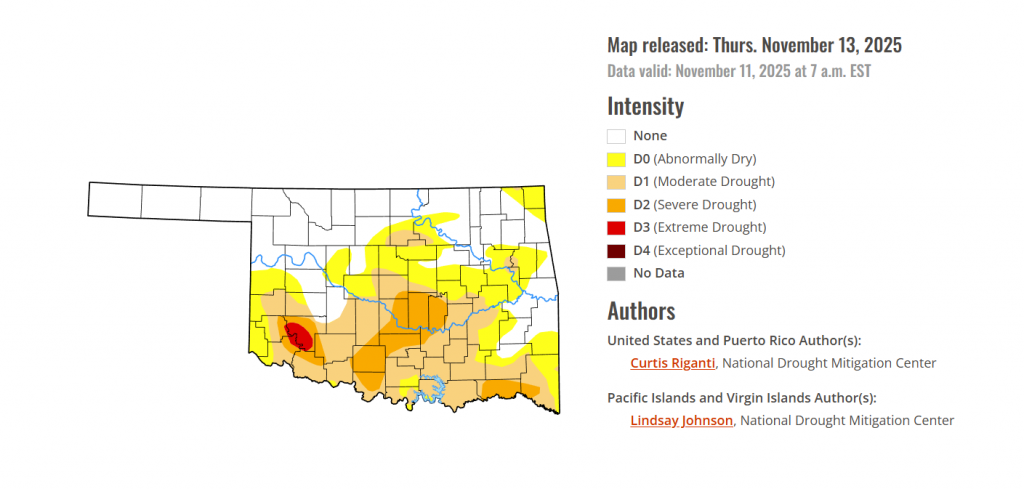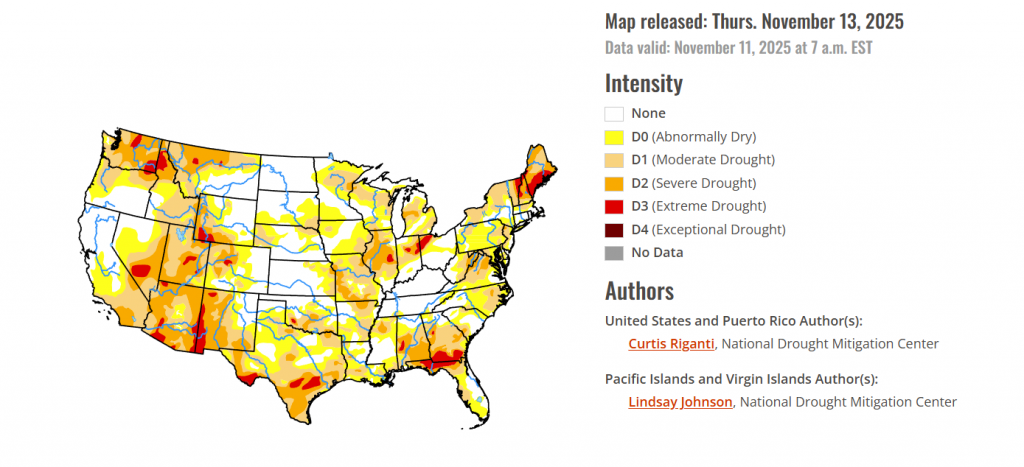
To view the latest Oklahoma drought map, CLICK HERE.
According to the latest Oklahoma Drought Monitor report, exceptional drought remains at 0 percent, unchanged from the start of the calendar year.
Extreme Drought (D3) has now emerged in southwestern Oklahoma in Kiowa, Jackson and Greer counties covering 0.8% of the state. some Examples of historically observed impacts during a D3 drought are: Air quality is poor, with dust storms and smoke, Cattle have little water and feed, Grasses are dormant and hay is nonexistent; planting is delayed; fields are spotty; emergency CRP grazing is authorized, Lakes are critically low; producers are hauling water for cattle; wells are drying, Wildfires are increasing in number and severity
Severe Drought: Severe drought (D2) is still present in southern Oklahoma, covering 10% of the state. Overall drought covers 57% of the state.
According to the 6-to-10-day precipitation outlook map, western Oklahoma is leaning above 60-70% chance of precipitation through November 22, while the rest of the state is leaning above 50-60% through that same date.

To view the United States Drought Map, CLICK HERE.
Mostly dry weather occurred this week across the Great Plains, Minnesota and Wisconsin, the south-central U.S. and the Southwest. The northern half of California, western Oregon, western Washington, the northern Idaho Panhandle and northwest Montana received moderate to heavy precipitation amounts. From northern California northward into the Pacific Northwest, amounts this week were locally over 3 inches. Locally higher precipitation amounts fell in the Northeast and in portions of the Great Lakes region. This included heavy lake-effect snow in north-central and northwest Indiana. Spotty rainfall amounts of over half an inch fell across the Southeast, but most of the region experienced a dry week. Drier weather in parts of the Great Plains and south-central U.S. led to widespread degradations, especially in Texas, Oklahoma and Louisiana. Heavy precipitation in Oregon and Idaho led to improvements in both states. Montana was split with improvement in the west and degradation in north-central areas, which continued a recent dry spell. Mostly drier weather in the Southeast led to degradations in Florida and southern Georgia and portions of Virginia. In northeast Illinois, northwest Indiana, Ohio, West Virginia and much of New England, improvements occurred after recent precipitation.

In the southern plains, Warmer-than-normal temperatures occurred across most of the South this week. Temperatures in Texas and Oklahoma were especially warm, with many areas in these states finishing the week 4-8 degrees above normal. Parts of southwest Texas were even warmer, with some sites finishing the week more than 10 degrees above normal. Most of the South remained dry this week, though a few parts of central and eastern Tennessee received over a half inch of precipitation. Degradations to abnormal dryness and drought were widespread from the southern half of Oklahoma to southwest Arkansas, and from central and eastern Texas into parts of Louisiana. Short-term drought impacts were the big story in southern Oklahoma, where short-term precipitation deficits grew and soil moisture and pond levels dropped and vegetation struggled. Streamflow levels struggled in portions of central and southern Texas, while soil moisture levels also dropped in south Texas amid unusually high evaporative demand for the time of year. Short-term precipitation deficits also drove some degradation in areas of abnormal dryness and moderate and severe drought in Louisiana.
In the High Plains, Temperatures in the eastern edge of the High Plains area remained mostly within a couple degrees of normal, as a strong cold front moved into the central U.S. near the end of the period. Otherwise, most of the region was warmer than normal, especially western Nebraska and central and western portions of Colorado and Wyoming, where temperatures from 4-8 degrees above normal were common this week. Some precipitation, generally under a half inch liquid equivalent, fell from central South Dakota to northeast Nebraska. Precipitation exceeding a half inch also fell in northwest Wyoming in the vicinity of Yellowstone National Park and in a section of the Black Hills of South Dakota. Elsewhere, mostly dry weather was the rule across the region. Short-term precipitation deficits grew in parts of eastern Nebraska, where abnormal dryness expanded in coverage north and northwest of Lincoln. Portions of western Nebraska and adjacent southeast Wyoming and Colorado continued to dry as well, and abnormal dryness and some moderate drought grew in these areas. In south-central Colorado, localized degradations were also due in part to effects from longer-term precipitation deficits.
In the Midwest, Precipitation amounts varied across the Midwest this week. Lake-effect snow fell in heavier amounts in northern Indiana, northeast Illinois, southwest Lower Michigan and portions of the Upper Peninsula of Michigan. Over half an inch of precipitation fell across much of Ohio and central and eastern Kentucky. Temperatures varied from generally 1-4 degrees below normal in northeast Wisconsin and Michigan to 2-6 degrees above normal in southern Missouri and western Kentucky. Temperatures were variable across the rest of the region, though most areas were within 4 degrees of normal. Heavier precipitation amounts recently in north-central Ohio led to improvements where streamflow and short-term precipitation deficits improved. Heavy snowfall in northwest Indiana and northeast Illinois led to improvement in soil moisture and precipitation deficits and improvements in drought and abnormal dryness. Farther south in east-central Illinois, severe and extreme drought expanded where streamflow levels dropped and short-term precipitation deficits worsened. Short-term precipitation deficits grew in south-central and southwest Wisconsin and abnormal dryness and moderate drought expanded there. Moderate drought also expanded in the northern Lower Peninsula of Michigan, where short-term precipitation deficits grew alongside declining soil moisture levels. Moderate drought expanded in a few spots in southeast Missouri, where recent dry weather added to short-term precipitation deficits amid poor soil moisture and streamflow levels.
To view the 6-10 Day Precipitation Outlook Map, click here.
To view the 6-10 Day Temperature Outlook Map, click here.
To view the Monthly Drought Outlook Map, click here.

















